|
It might seem a little spurious to start making comparisons between Japanese chanbara samurai films and American TV detective dramas, but there are a couple of similarities worth noting. Both play to specific formulas and are built around the personality and skills of their central character, one who is distinguished from his counterparts in other works of the same genre by a particular and notable character trait. Thus we have the scruffy and dogged detective in Columbo, the OCD detective in Monk, the little old lady detective in Miss Marple, and back in 1971 we even had a blind investigator in Longstreet, who in the very first episode was taught self-defence by a then little known Chinese-American actor named Bruce Lee. It's a similar story with Japanese samurai film series, whose distinctive antiheroes include blind swordsman Zatoichi and masochistic sex-torturing policeman Hanzo the Razor, both of whom were played by legendary actor Katsu Shintaro. The three-film Hanzo series was based on the manga Goyōkiba by Koike Kazuo, who was also responsible for a phenomenally successful manga titled Lone Wolf and Cub, whose ronin-for-hire is distinguished by being partnered by his four-year-old child. These were also made into a film series, this time starring Wakayama Tomisaburo, the older brother of Katsu Shintarō of Zatoichi and Hanzo fame, who also co-produced the first three films.
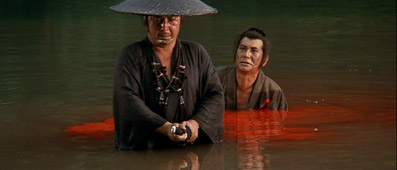
Wakayama stars as Ogami Ittō, the Shogun's executioner and a swordsman of singular skill, who goes on the run with his infant son Daigoro after his wife is killed and he is framed for treason by members of the unscrupulous Yagyu clan, working under the direction of corrupt patriarch Retsudo. Ittō's weapon of choice is a dōtanuki, or as the subtitles suggestively have it, a torso-cutting sword, but he has a number of other weapons concealed in the bamboo of Daigoro's baby cart. Ittō practices the Sui-o fighting style, and after six films I'm still not sure I know exactly what that means. It's certainly effective, enabling Ittō to take on everyone from single warriors to garrisons of fighters without suffering serious injury. Ittō works exclusively as an assassin for hire for a standard fee of 500 pieces of gold, and once he has accepted a commission he will always see it through, whatever moral complications might arise en route.
The Lone Wolf and Cub films are not action movies in the traditional western sense, but thoughtful and enthralling historical dramas in which action plays a significant role. Violent though the battles may be, rarely is action staged purely for its own sake, and except for the increasingly epic finales of the last four films, will last only as long as the situation demands, which for someone of Ittō's skill with a sword means a fight can be over in the blink of an eye. There's a recognisable spaghetti western influence to the series, with the build-up to fights given more screen time than the combat itself, only appropriate given that Sergio Leone's genre-defining A Fistful of Dollars was a direct remake of Akira Kurosawa's celebrated chanbara Yojimbo.
Making his movie debut in the 1972 Lone Wolf and Cub: Sword of Vengeance [Kozure Ōkami: Kowokashi udekashi tsukamatsuru], Ittō appeared in a total of six home-grown features, films whose casual nudity and blood-letting ensured that they remained largely unseen in the UK. Although the violence can be extreme – limbs are severed, blood gushes like it's being sprayed from a fire hose, and occasionally opponents are sliced in two – it seems likely that Diagoro's presence was also a factor in UK censor apprehension, a four-year-old boy who witnesses countless violent deaths, participates in a few himself, attracts the attention of a naked woman by brushing her nipple, and at one point is stripped of his clothes and publicly beaten.
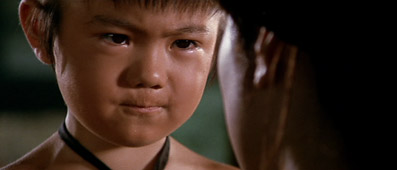
Realising their commercial potential at a time when the popularity of martial arts cinema was at a periodic high but presumably a little nervous about the more contemplative elements, American director Robert Houston and his partner David Weisman re-edited the first two films into a single feature, altering and simplifying the plot, re-recording the dialogue in English and commissioning a new Moog score from Mark Lindsay and W. Michael Lewis. The result was the 1980 Shogun Assassin, which was released by Roger Corman's New World Pictures and became a grindhouse cult favourite. Typically, its extreme violence saw that film's subsequent video release banned in the UK.
Eureka's new box set brings together all six of the original films, uncut and digitally remastered, together with Shogun Assassin, allowing you to gaze in wonder at how the first two films were reworked for the American market.
| Lone Wolf and Cub: Sword of Vengeance / Kozure Ōkami: Ko wo kashi ude kashi tsukamatsuru (1972) |
|
It's here that Ittō Ogami is introduced, his wife is killed and he is framed by the Yagyu clan, all revealed in flashback as he wanders the countryside pushing Diagoro in his bamboo baby carriage and advertising himself as an assassin for hire. It's typical of the engaging quirkiness of the series that their first customer hires not Ittō but Daigoro, who serves briefly as a surrogate baby to be frantically mothered by a distraught woman who has recently lost her own child.
This early scene-setting lays the ground for both the series as a whole and the storyline that occupies the film's second half, which kicks off when Ittō walks into a rural onsen (hot spring) village to find it under the control of a group of armed bandits. Rather than fight them, he plays the innocent and submits to their authority and is thrown in with a group of imprisoned villagers. When he's threatened with execution, it's prostitute Osen who begs for his life, which the bandits agree to spare if Ittō has sex with Osen while they watch. Ittō agrees and does the deed, and when the others scorn his cowardice Osen angrily asks which of them could have performed to order under such circumstances. When the bandits announce that the time has come to kill all those who have seen their faces, Ittō springs into action.
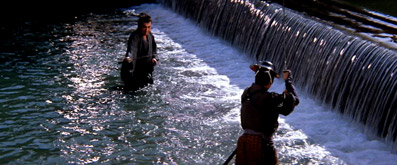
The tone for the series is set here, notably in the top-half female nudity (a peculiarity of Japanese censorship forbids the display of pubic hair), the deliberate pacing, the key role played by character and storytelling, Ittō and Diagoro's instinctive and largely non-verbal communication, and Kusumoto Eiichi's expert fight choreography. The extreme nature of the stylised violence is also on show, with the swordplay resulting in geysers of blood, multiple amputations, and in one extreme case a bandit separated from his still standing lower legs.
It's a captivating introduction to the series, with Wakayama's stony-faced stoicism shaping Ittō into an enigmatic antihero, his lack of expressed emotion also a key characteristic of young Diagoro, who is beguilingly played by four-year-old Tomikawa Akihiro without a hint of western-style cuteness. It also looks a treat, thanks to Chishi Makiura excellent scope cinematography and some eye-catching editing and montage work from Taniguchi Toshio. Both men had already cut their jidaigeki teeth on later Zatoichi films, a training ground shared by director Misumi Kenji, who came to this film straight from Hanzo the Razor: Sword of Justice and who keeps the drama enthralling enough to easily sustain the extended second-half tease as we wait for Ittō to put the bandits firmly in their place.
| Lone Wolf and Cub: Baby Cart at the River Styx / Kozure ōkami: Sanzu no kawa no ubaguruma (1972) |
|
The second film in the series kicks off with an almost Python-esque image (I'm specifically referencing Holy Grail here) of a straw helmeted warrior running straight at the camera as the inexpressive Ittō and Diagoro watch and prepare for his arrival, two images that are cross-cut with increasing speed as the figure nears its target. His attack is foiled when Ittō buries his sword into the man's forehead, but it turns out to be a ruse, an act of self-sacrifice that allows his hidden companion to leap from behind him and attack the now disarmed Ittō, a move that is parried using a weapon concealed in the bamboo of Diagoro's baby cart. It's an opening that very much sets the tone for this compellingly told and gorgeously shot sequel to Sword of Vengeance, in the re-establishment of the Yagyu clan's determination to kill Ittō and the repeated attempts made on his life, in the confirmation of Ittō's superior reflexes and skills, and in the increased role the baby cart and its array of hidden weaponry will play in his battles with the Yagyu clan and their associates.
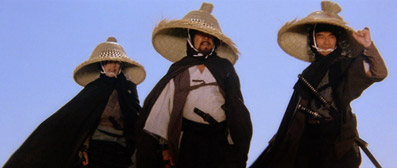
Here Ittō is hired by members of the Awa clan (the demonstration he provides them of his skills is a doozy), whose lucrative indigo dye monopoly is threatened when their head artisan Makuya defects with the dye's production secrets. The clansmen hire Ittō to kill Makuya, but warn that he is being collected and protected by the Hidari brothers, a trio of escorts with specialist weaponry and a lethal fighting style, something violently demonstrated on a posse of Awa warriors who attempt to jump them before they collect Mukuya.
It's assumed from the start that we've seen the first film, which is briefly referenced when Kurokana clan leader Ozunu tells Sakaya, the female leader of the Akashi branch of the Yagyu clan, about the death of two key clan warriors at Ittō's hands. The furious Sakaya pledges to kill Ittō, and when Ozunu warns her of the ronin's skills, she demonstrates those of her female warriors by setting them loose on Ozunu's finest ninja, who is quickly separated from chunks of his face, most of his limbs, and then his life. Their attempts to dispatch Ittō are less successful, with three inventive attacks being mercilessly countered. Diagoro helps out for the first time here – having clearly learned all of his cart's deadly tricks, he calmly dispatches one of the female assailants with a simple lever press.
The second film in the series is one of the best, weaving a more complex and multi-threaded narrative and providing a little more insight into Ittō's relationship with his young son. It boasts a string of memorable highlights, including a shipboard encounter in which Ittō and the Hidari brothers quietly size each other up, an assault on Sakaya that turns out to be an act of collective survival, a woodland battle in which the baby cart is transformed into a deadly Boudica-like chariot, a wordless and enthralling scene in which Diagoro tends to the injured Ittō's wounds, and a stand-off in which Sakaya threatens to drop Diagoro into a deep well unless his father surrenders. The climactic battle in the Oura Sand Dunes has its own stand-out moments, from the wince-inducing manner in which hidden Awa soldiers are exposed to the warrior who is split down the middle by Ittō's sword, though for left-field peculiarity the fatally injured man who takes time out to philosophically contemplate the sensation of having his throat cut takes some beating.
| Lone Wolf and Cub: Baby Cart to Hades / Kozure ōkami: Shinikazeni mukau ubaguruma (1972) |
|
While Baby Cart at the River Styx effectively showcased Ittō in combat, Baby Cart to Hades sees him repeatedly avoid it. This shift of approach is first demonstrated when he encounters Kanbei, a former samurai now working as a hired hand, who intervenes when his workmates attack and rape a woman and her daughter. Arriving too late to prevent the crime, he kills the two women (in a chilling moment, he calmly requests that one of the women close her eyes before before she is slain) and has his workmates draw lots to select who will die and take the blame for the assault. Kanbei instantly recognises Ittō and as a fellow warrior requests a duel. The two square off, but Ittō stands down, advising Kanbei that a warrior such as he deserves to live. The two are clearly destined to meet again.
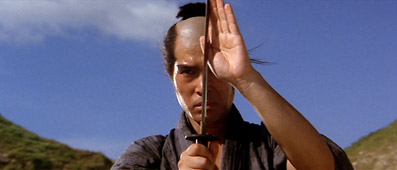
A short while later at a hotel in which Ittō and Diagoro are staying, a prostitute who is shortly to be owned by the Bohachimono Yakuza group kills her would-be pimp and flees to Ittō's room to beg for protection. Female Yakuza leader Torizo demands her return, but Ittō refuses to hand her over. An attempt to take her by force is deflected rather than defeated and Ittō agrees to suffer a torturous punishment in her place to free her from her obligations. To set things right for the death of the pimp, he accepts a commission from Torizo and her father – whose arm he once accidentally severed during a bungled execution – to kill a corrupt but well guarded district deputy.
Both of these conflicts are sidestepped on matters of honour, a particular focus for the third film's narrative, whose diminished combat gives this chapter its own specific and compelling identity and sheds further light on Ittō's character. The brief explosions of swordplay are still there – in a particularly inventive sequence, Ittō suddenly draws his sword and cuts through the surrounding bamboo to bring the Yagyu ninja hidden above sharply down to earth – but the action is largely kept on hold for the climax, where Ittō single-handedly battles an army of warriors and the baby cart is revealed to contain not just an array of hidden blades but a home-made gatling gun. It's a credibility jump that briefly reminds us we're watching a live action manga, one that sets the pattern for climactic battles to come.
| Lone Wolf and Cub: Baby Cart in Peril / Kozure ōkami: Oya no kokoro ko no kokoro (1972) |
|
How's this for filmic economy? Topless and tattooed swordswoman Oyuki is challenged by four warriors of the Owari clan and charged with desertion. They attack but she easily defeats them all, then cuts off their topknots, a key symbol of their samurai status. Later, at a different location, an unidentified woman pleads with Ittō to kill Oyuki, a commission he accepts for his usual price. Screen time elapsed: ninety seconds. Ninety immaculately composed and edited seconds, I might add. And come back to this scene after watching the film and you'll understand the true significance of that post-mortem haircut and the real reason for Oyuki's semi-nakedness. You may also have an idea of who has commissioned Oyuki's death and why. Four films in and there's no sign of the quality dropping.
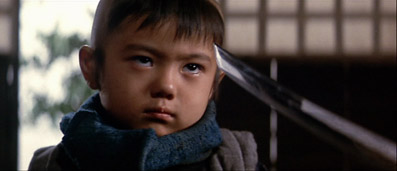
There are, however, some small shifts from the established formula, all of which spring from Diagoro's accidental separation from his father and are restricted to this one film: we get our first taste of explanatory voice-over; are introduced to a possible long-term foe in the shape of lone Yagyu warrior Gunbei (who never appears again); and Diagoro's misfortune is outlined in a tell-it-like-we-see-it song, one addition I could happily have lived without. But we're soon back on track as Diagoro resourcefully escapes a fire and is reunited with his father, and the two continue their pursuit of Oyuki – sympathy for whom is ensured when the reasons for her actions are revealed in one of the film's multiple flashback sequences – through her former profession as a street entertainer.
Although new to the series, director Saito Buichi retains its look and tone, perfectly balancing the action and drama with the more contemplative moments, which once again unfold in resolutely unhurried but compelling fashion. Even more so than before, Ittō finds himself torn between duty and honour, most evident in his encounter with Oyuki after her own thirst for vengeance is memorably satiated. There are a couple of striking set-pieces, the best of which sees Ittō enter a run-down temple where ninjas are waiting disguised as statues – in their dying moments and plastered with grey make-up they look more like the living dead than the covert warriors of legend. It all builds to a climactic battle that's clearly intended to top that of its predecessor, and once again sees Ittō take on a legion of warriors single-handedly with everything from swords to his baby cart gatling gun, a fight from which he does not escape unscathed. It ends with more than a whiff of 'too be continued' and a degree of uncertainty about Ittō's fate, which is soon settled in...
| Lone Wolf and Cub: Baby Cart in the Land of Demons / Kozure ōkami: Meifumadō (1973) |
|
With his injuries now healed, Ittō is approached by the first of five assailants from the house of Kuroda, each of whom have been sent to test Ittō's skills and are carrying 100 gold pieces – if Ittō defeats them he earns a fifth of his fee, while further details of the proposed mission are delivered by the fatally wounded emissaries in their final moments of life. The battles are short but the encounters intriguing, none more so than the warrior who dutifully delivers his prescribed information as his body is gradually consumed by fire. The final piece of the jigsaw is provided by the cheerful Kenbei, who attempts to poison Ittō with tea that he keeps warm in a thermos flask made from bamboo and clay. Now you know where that idea came from.
It's revealed that the Kuroda clan is facing disaster due to a deception that has seen Hamachiyo, the five-year-old female offspring of Lord Kuroda's concubine Otae, installed as his heir in place of the secretly imprisoned Prince Matsumaru. For reasons best known to himself, Lord Kuroda has recorded the full details of this in a secret document that he has trusted to Abbot Jikei, High Priest of the family temple and regarded by many as a living Buddha. But the Kuroda clansmen have since discovered that Jikei is the head of a network of ninja spies and that he intends to hand the document to Ittō's mortal enemy Retsudo.
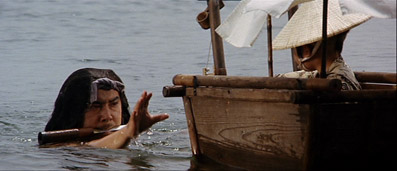
Having set up the story in such an enticing and extended manner, the diametric opposite of the quick one-two of the commission and acceptance in Baby Cart in Peril, the film then takes a detour to introduce new characters and tell a short tale of self-realisation and redemption involving the wonderfully named pickpocket Quick Change Oyō. Having little bearing on the main plot, it nonetheless proves a riveting sidestep that further complicates the bond between Diagoro and his father, one whose image of a defiant five-year-old being stripped and publicly flogged is likely to have a portion of the (English-speaking) audience shifting in their seats. They'll have more to worry about when Ittō accepts a second commission from Matsumaru's warrior governess Shiranui to execute Hamachiyo and her mother – this far into the series you'll be well aware that Ittō does not let issues of morality prevent him from completing his paid duty.
The fight choreography is as impressive as ever, and returning to the director's chair after a one-film break, series regular Misumi Kenji gets more adventurous with his camera angles, but in a way that breathes a stylistic freshness into the action scenes without diluting their impact. This gives rise to some superb set-pieces, including Ittō's improbable but arrestingly staged underwater assault on Jikei's heavily guarded river transport and an excellent climactic battle that pits him against an army of warriors in the rooms and corridors of the Kuroda palace.
Collectively it's dynamite stuff, and although there's a remarkable consistency of quality across the entire six-film series, Baby Cart in the Land of Demons has emerged as my personal favourite.
| Lone Wolf and Cub: White Heaven in Hell / Kozure ōkami: Jigoku e ikuzo! Daigorō (1974) |
|
Ittō's feud with the Yagyu clan continues unabated, and with most of the original clan members now slain, Retsudo sends his rigorously combat-trained daughter Kaori to kill Ittō. It's typical of the series' refusal to play to expectations or convention that, having established her lethal skills in a manner that in a western actioner would set her up for a long chase and a climactic stand-off, Kaori locates and is dispatched by Ittō in a matter of minutes. The desperate Retsudo turns to his previously shunned offspring Hyoei, the leader of a group of specially skilled ninjas known as the Spider Demons, who practice dark magic and whose top practitioners are able to burrow face-first beneath the ground like supernatural moles, giving rise to some of the creepiest imagery in the series.
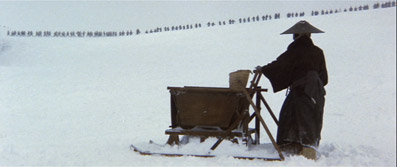
This drift towards fantasy is grounded by keeping the combat physical and allowing conditions to restrict the Spider Demons' abilities – while in marshland they are able to sneak up on Ittō and pull him into the earth like human quicksand, their techniques are rendered largely ineffective by the frozen ground he subsequently leads them into. Come the inevitably large-scale finale, however, all restraint is thrown to the wind, as Ittō takes on a hoard of skiing samurai in a climax that feels more James Bond than Japanese chanbara, while Ittō's heavy use of the cart's gatling guns suggests its bullets are sourced from the same secret stash that kept the Where Eagles Dare team supplied with bombs and timers.
The ending implies that more films were planned, or at least that the door was being left open for them to be made, but I like to think the filmmakers chose quit while they were ahead – attempting to top the climax here may well have pushed the series into the realms of comic book absurdity. There's still a great deal to admire and enjoy here, the standout scene being an attack made on Ittō by Hyoei and the Spider Demons at a lakeside house, which peaks with Ittō battling a string of fighters in a static wide shot that impressively showcases Kusumoto Eiichi's fight choreography and, in its small way, prefigures the famous corridor fight from Oldboy.
How you react to this American re-edit of the first two films will be governed in part by whether you choose to watch it before or after the Japanese originals. Even if you catch it first then your perception of it is likely to alter after you've seen the other films. Although the essence of the plot has remained the same – Ittō goes on the run with Diagoro and works as an assassin for hire after his wife is killed – there's plenty of difference in the detail. Here Retsudo has been recast as a mentally unstable Shogun who orders Ittō's death out of paranoid fear. The subsequent story, constructed from the first half of Sword of Vengeance and sizeable chunks of Baby Cart at the River Styx, plays out largely as before, but with changes made to character and plot details, while most (though not all) of the more meditative moments have been trimmed or redesigned. The most drastic change is to have the whole thing narrated in 'thoughts' voice-over by Diagoro, which in that familiar American movie manner strips scenes of their ambiguity by spelling out what we were previously allowed to surmise for ourselves.
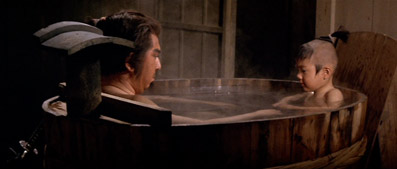
Mark Lindsay and W. Michael Lewis's replacement electronic score is actually rather good in places, particularly the use of low drones to suggest approaching menace, while its jaunty pop-rock pieces are no more incongruous than the guitar twanging funkadelic numbers you'll find in the originals. The English dub is a different story, with the mismatch of voices to characters, coupled with the shoehorning of English phrases into the spaces left by the vastly different Japanese sentence structure, giving serious scenes and unintentional comic edge. Old men in particular are played almost as pantomime crones by far younger voice artists (the Awa clan representative who delivers the commission is a riot), while Sakaya's accent wanders unsteadily between English and French. Now that we have access to the originals, it's a lot harder to warm to the rebuild.
All six films have been digitally restored and look wonderful. There are some minor variations in quality depending on the film in question and the lighting conditions of specific scenes, but at best the sharpness is excellent, the contrast just right (after a slightly harsh start on Sword of Vengeance), the black levels solid and the colours vivid – the blood in particular is almost luminous in places, and you'll get plenty of opportunities to match it to the appropriate Pantone card. Of the seven, Shogun Assassin is probably the weakest, having a distinct orange tinge to faces at times, but even this looks better than you've probably seen it before. There's hardly a dust spot to be seen throughout the collection (a few brief appearances on a couple of the title sequences only) and there's not a trace of damage anywhere. Excellent. All seven films are framed 2.35:1 (except Sword of Vengeance, which is 2.40:1) and anamorphically enhanced.
The mono 2.0 soundtracks have also been cleaned up, but have a sometimes limited dynamic range and exhibit some distortion on the louder music, particularly noticeable on Baby Cart at the River Styx.
Each of the discs features the Original Trailer for the film in question, typically insightful Sleeve Notes from Asian film expert and midnighteye.com editor-in-chief Tom Mes, and reproductions of the original posters (I especially liked these).
A wonderful seven-disc set featuring six of the best samurai action dramas you'll ever see and a cult American reworking of the first two. Gorgeously restored and handsomely packaged, they may be light on extras but for content alone this has to be a front runner for DVD box set of the year. Very highly recommended.
The Japanese convention of surname first
has been used for all Japanese names. |